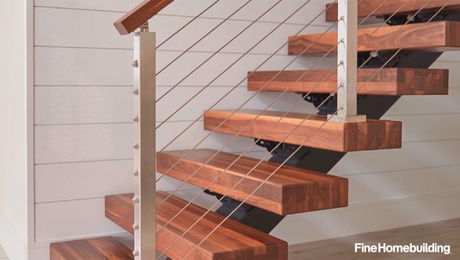What is your preferred way to anchor the sills of the framed walls, atop a slab foundation?
I was thinking we would set pressure-treated 2×4 plates, fixed to the slab perimeter with anchor bolts we would embed at slab pour time, then build walls atop that. But it occured to me that the only thing fastening the walls to the anchored PT sill would be the spikes we would shoot through our bottom wall plate into the PT.
It’s not that I am in tornado or hurricane country here, but we are in a seismic zone 2, and if we are anchoring, we ought to do it right.
Maybe we should just build the walls with PT bottom plates, and drill ’em for the bolts, and set the walls over, then snug up with nuts and washers.
We are complicating things just a little bit because we are thinking of buying the package panelized, which means we will be crane-setting presheathed wall panels in place, right off the delivery truck.



















Replies
I think your pressure treated bottom plate and hilti bolts, for example, would work OK. Are you going to thicken the perimeter for a footing? Make sure you bolt on either side of any door openings.
That is the way I do it, but we also shoot sheathing nails into the PT when the wall is stood
Welcome to the
Taunton University of Knowledge FHB Campus at Breaktime.
where ...
Excellence is its own reward!
There are a few options. One would be to do just what you said, but in addition, lay metal strap underneath the sill, perpendicular to the sill. Then, after the walls are framed, bend the strap up on each side and nail it to the studs.
Another method is to make sure the exterior sheathing hangs over the bottom by an inch and a half. When the walls are nailed on, drive nails through the sheathing into the sill plate. This only works of course if you use structural panels for the sheathing, like plywood. It won't work if you used that fibrous Celotex panel material or foam insulation. But if you want to protect against seismic damage you wouldn't use them anyway.
There are a number of engineered hold down systems for all sorts of configurations.
Remember that the new pressure treated lumber is more corrosive and requires special rated metal in contact with it, whether it be nails, straps, or anchor bolts. Ordinary plumber's strapping or electrogalvanized nails are not sufficient.
It's good to install plastic foam sill seal. It reduces air infiltration and creates a moisture break between the wood and the concrete.
Edited 11/6/2004 4:35 pm ET by WAYNEL5
they also make a metal strap that embedded in the concrete during placement and then these are wrap around the sill plate.
Bob
fastest way I know and easiest is to stand your walls ( no PT sill preinstalled, no bolts poured in slab ) pin and straighten with hand driven conc nails then drill 1/2 inch holes through the plate into the slab and install threaded rod with epoxy. Here we use Ramsets "Chemset"101 ( not those crappy one piece glass vial but a two pack gun system ) to do the job. I believe Powers have a similar system. We actually run our threaded rod right up to the top plate as we have some fairly large uplift forces to contend with. Each rod gives us 15kn resistance ( sorry don't know what that is in your language ).
regards
Mark
http://www.quittintime.com
15 kn = 3272 pounds
That's the way I'm building in the hurricane zone called Florida. Many new house builders here hire a specialized crew whose ONLY job is to go around and install the steel in the buildings. That includes drilling and epoxying the all thread and nailing off all other straps or tiedowns. The framers used to do that.
If I put up an off grade structure, I'll drill the stem wall and epoxy short lengths of all thread to just above bottom plate height then start the framing, finishing off with a coupling and another length of all thread to the top plates. I use the Hilti epoxy product.
Bob,
Just built one on a mono slab. We puddled the anchor bolts in at the pour, built the walls with treated bottom plate and lifted them over the anchor bolts.
It helps to set your framed wall on some 2x scrap stock and line up the holes then pry up and remove the scrap to let wall down on the anchor. Beats the heck out of trying to beat the wall down over the anchor.
Cole
Cole Dean
Dean Contracting
Bob
You pouring an 8" foundation wall on top of the slab first around the perimeter first before setting in anchor bolts?
If youre worried about just using the bolts....use more of them and longer ones.
Be well
andy
The secret of Zen in two words is, "Not always so"!
The best things in life are nearest: Breath in your nostrils, light in your eyes, flowers at your feet, duties at your hand, the path of right just before you. Then do not grasp at the stars, but do life's plain, common work as it comes, certain that daily duties and daily bread are the sweetest things in life.
—Robert Louis Stevenson
http://CLIFFORDRENOVATIONS.COM
It's a thickened edge slab, monolithic.
For a stick-built frameup, we would probably just set embedded bolts on 4/0 centers, mindful of door openings. Then we would template the PT plates to the bolt locations, bore for bolts, then frame the walls laying flat, and tip 'em up onto 2-1/2" blocks, bang around with sledges to align holes to bolts, then sledge out the jackblocks.
But after reading responses here, it will be quicker and easier if we don't embed any bolts, but simply drill for and place expansion anchors afterwards. We can pop up the walls, pin them through the bottom plates with shot nails, and do the anchor bolt work later.